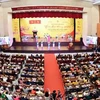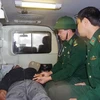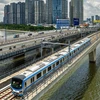 Bac Bo Phu (Tonkin Palace) was taken over by the Vietnamese force on October 9, 1954. It is currently the Government Guest House. The site, a historical monument in the Hoan Kiem district, represents French colonial architecture. It was formerly the Residential Palace of the Tonkin Governor, built between 1918 and 1919 to house the French Governor of Tonkin. It was renamed "Bac Bo Phu" when Viet Minh (League for the Independence of Vietnam) took over northern Vietnam in 1945 (the August Revolution), which led to the establishment of the Democratic Republic of Vietnam, now the Socialist Republic of Vietnam, on September 2 the same year. (Photo: VietnamPlus)
Bac Bo Phu (Tonkin Palace) was taken over by the Vietnamese force on October 9, 1954. It is currently the Government Guest House. The site, a historical monument in the Hoan Kiem district, represents French colonial architecture. It was formerly the Residential Palace of the Tonkin Governor, built between 1918 and 1919 to house the French Governor of Tonkin. It was renamed "Bac Bo Phu" when Viet Minh (League for the Independence of Vietnam) took over northern Vietnam in 1945 (the August Revolution), which led to the establishment of the Democratic Republic of Vietnam, now the Socialist Republic of Vietnam, on September 2 the same year. (Photo: VietnamPlus)  Bac Bo Phu witnessed several historic moments in Vietnam during the August Revolution in 1945 and the Capital Liberation Day in 1954. The classic French building, located at 12 Ngo Quyen street (Henri Rivière Boulevard), was designed by Adolphe Bussy with some style influences from the Napoleon III era. The house, built in 1918, survived the resistance wars against France and the US. It was also the residential and working place of then President Ho Chi Minh on the first days of the Democratic Republic of Vietnam. Today, the site, the Government Guest House, is the official residence for distinguished government guests. (Photo: VietnamPlus)
Bac Bo Phu witnessed several historic moments in Vietnam during the August Revolution in 1945 and the Capital Liberation Day in 1954. The classic French building, located at 12 Ngo Quyen street (Henri Rivière Boulevard), was designed by Adolphe Bussy with some style influences from the Napoleon III era. The house, built in 1918, survived the resistance wars against France and the US. It was also the residential and working place of then President Ho Chi Minh on the first days of the Democratic Republic of Vietnam. Today, the site, the Government Guest House, is the official residence for distinguished government guests. (Photo: VietnamPlus)  The Flag Tower of Hanoi, built under the reign of the Nguyen Dynasty (1802 - 1945), witnessed the historic flag hoisting ceremony in the afternoon of October 10, 1954, after the liberation troops had taken over the capital city earlier the same day. It is one of the city's symbols at present and was once a part of the Imperial Citadel of Thang Long - a world heritage site recognised by the United Nations Educational, Scientific and Cultural Organisation (UNESCO). Its height is 33.4 metres (41.4 metres with the flag). The tower was built in 1812 as an observation post to the Imperial Citadel. It is now located in the Vietnam Military History Museum. (Photo: VietnamPlus)
The Flag Tower of Hanoi, built under the reign of the Nguyen Dynasty (1802 - 1945), witnessed the historic flag hoisting ceremony in the afternoon of October 10, 1954, after the liberation troops had taken over the capital city earlier the same day. It is one of the city's symbols at present and was once a part of the Imperial Citadel of Thang Long - a world heritage site recognised by the United Nations Educational, Scientific and Cultural Organisation (UNESCO). Its height is 33.4 metres (41.4 metres with the flag). The tower was built in 1812 as an observation post to the Imperial Citadel. It is now located in the Vietnam Military History Museum. (Photo: VietnamPlus)  The yard next to the Hanoi Flag Tower was the venue of the first flag hoisting ceremony on Capital Liberation Day on the afternoon of October 10, 1954. The pyramid-shaped tower comprises three tiers with a spiral staircase leading to the top inside. The first tier is 42.5 metres wide and 3.1 metres high, the second is 25 metres wide and 3.7 metres high, and the third is 12.8 metres wide and 5.1 metres high. The second tier has four doors. The tower is lighted by 36 flower-shaped and six fan-shaped windows. The national flag of Vietnam is on top of the tower. (Photo: VietnamPlus)
The yard next to the Hanoi Flag Tower was the venue of the first flag hoisting ceremony on Capital Liberation Day on the afternoon of October 10, 1954. The pyramid-shaped tower comprises three tiers with a spiral staircase leading to the top inside. The first tier is 42.5 metres wide and 3.1 metres high, the second is 25 metres wide and 3.7 metres high, and the third is 12.8 metres wide and 5.1 metres high. The second tier has four doors. The tower is lighted by 36 flower-shaped and six fan-shaped windows. The national flag of Vietnam is on top of the tower. (Photo: VietnamPlus)  The Hanoi Opera House, located in Hoan Kiem district, was where a siren sounded to mark the historic flag hoisting ceremony at 3 pm on October 10, 1954. The creators of the Hanoi Opera House, a neoclassic-style theatre, were three French architects. The design was partly based on the Garnier Opera House in Paris. It was built in 1901 and is now one of Hanoi's most famous architectural landmarks. The place was where the first National Assembly of independent Vietnam convened the first session and adopted the 1946 Constitution – the country's first constitution. The theatre at 1 Trang Tien street has a capacity of 900 seats and is used for music programmes, chamber music concerts and plays. (Photo: VietnamPlus)
The Hanoi Opera House, located in Hoan Kiem district, was where a siren sounded to mark the historic flag hoisting ceremony at 3 pm on October 10, 1954. The creators of the Hanoi Opera House, a neoclassic-style theatre, were three French architects. The design was partly based on the Garnier Opera House in Paris. It was built in 1901 and is now one of Hanoi's most famous architectural landmarks. The place was where the first National Assembly of independent Vietnam convened the first session and adopted the 1946 Constitution – the country's first constitution. The theatre at 1 Trang Tien street has a capacity of 900 seats and is used for music programmes, chamber music concerts and plays. (Photo: VietnamPlus)  The Imperial Citadel of Thang Long was the rendezvous of the three wings of Brigade 308, which took over the capital city on October 10, 1954. Built-in the 11th century during the Ly Dynasty (1009 - 1225), it was a power centre for over a thousand years of Vietnamese history and unique evidence of the Vietnamese civilisation during the development of monarchies in Southeast Asia and East Asia. The central section of the imperial citadel was recognised as a special national relic site in 2009 and a world heritage site in 2010. Since then, it has gradually gained popularity among domestic and foreign tourists and served as a venue for many major cultural events in Hanoi's capital city. (Photo: VietnamPlus)
The Imperial Citadel of Thang Long was the rendezvous of the three wings of Brigade 308, which took over the capital city on October 10, 1954. Built-in the 11th century during the Ly Dynasty (1009 - 1225), it was a power centre for over a thousand years of Vietnamese history and unique evidence of the Vietnamese civilisation during the development of monarchies in Southeast Asia and East Asia. The central section of the imperial citadel was recognised as a special national relic site in 2009 and a world heritage site in 2010. Since then, it has gradually gained popularity among domestic and foreign tourists and served as a venue for many major cultural events in Hanoi's capital city. (Photo: VietnamPlus)  Doan Mon, the main entrance to the Thang Long Imperial Citadel, also witnessed many historical moments of Hanoi, including the flag hoisting ceremony on October 10, 1954. Kinh Thien Palace is the main building in the central section of the citadel, located in downtown Hanoi. It sits at the centre of the complex and faces Doan Mon and the Hanoi Flag Tower. The palace was built in 1428 and is believed to be of the highest importance as it hosted many royal ceremonies and was also where royal audiences were invited to discuss national issues. French colonialists almost destroyed it at the end of the 19th century. (Photo: VietnamPlus)
Doan Mon, the main entrance to the Thang Long Imperial Citadel, also witnessed many historical moments of Hanoi, including the flag hoisting ceremony on October 10, 1954. Kinh Thien Palace is the main building in the central section of the citadel, located in downtown Hanoi. It sits at the centre of the complex and faces Doan Mon and the Hanoi Flag Tower. The palace was built in 1428 and is believed to be of the highest importance as it hosted many royal ceremonies and was also where royal audiences were invited to discuss national issues. French colonialists almost destroyed it at the end of the 19th century. (Photo: VietnamPlus)  Dong Xuan Market was where the Vietnamese troops passed by before gathering at the Imperial Citadel of Thang Long in October 1954. Built in 1889, the market comprises five buildings with a total area of around 6,500 square meters. Behind five triangular arches on the facade is a corrugated roof. The market at 15 Cau Dong street used to be the biggest in the north and was burned down in a fire in 1994. The next year it was rebuilt at the cost of nearly 68 billion VND (nearly 3 million USD) into a three-storey building with 14,000 square meters of floor area. It houses more than 2,000 stores at present. (Photo: VietnamPlus)
Dong Xuan Market was where the Vietnamese troops passed by before gathering at the Imperial Citadel of Thang Long in October 1954. Built in 1889, the market comprises five buildings with a total area of around 6,500 square meters. Behind five triangular arches on the facade is a corrugated roof. The market at 15 Cau Dong street used to be the biggest in the north and was burned down in a fire in 1994. The next year it was rebuilt at the cost of nearly 68 billion VND (nearly 3 million USD) into a three-storey building with 14,000 square meters of floor area. It houses more than 2,000 stores at present. (Photo: VietnamPlus)  Hanoi Station, whose old name was Hang Co Station, was one of the first facilities the Vietnamese troops took over from the French colonialists on the morning of October 9, 1954. The railway station is located at 120 Le Duan street, Cua Nam ward of Hanoi's Hoan Kiem district. In 1895, the French colonialists chose the Hang Co Market area to build the main station of Hanoi. It was opened in 1902 and became one of the largest in Indochina then. Before the proliferation of flights and highways, Hanoi Station used to play a vital role in connecting the capital with the rest of Vietnam. (Photo: VietnamPlus)
Hanoi Station, whose old name was Hang Co Station, was one of the first facilities the Vietnamese troops took over from the French colonialists on the morning of October 9, 1954. The railway station is located at 120 Le Duan street, Cua Nam ward of Hanoi's Hoan Kiem district. In 1895, the French colonialists chose the Hang Co Market area to build the main station of Hanoi. It was opened in 1902 and became one of the largest in Indochina then. Before the proliferation of flights and highways, Hanoi Station used to play a vital role in connecting the capital with the rest of Vietnam. (Photo: VietnamPlus)  Hanoi Station was built and unveiled in the early 20th century. It is only 2km away from the lively Old Quarter area of the capital city. There are a lot of shops and restaurants within easy walking distance of the railway station. It comprises two parts: Part A and Part B, with Party A more impressive. The terminal in Part A has a distinctive modernist architectural design feature, which was added to the original building in 1976. The central part of the building was bombed during the resistance war against the US, leaving only the wings of the original building intact. What was built in place of the damaged central section is modern, bold and striking. (Photo: VietnamPlus)
Hanoi Station was built and unveiled in the early 20th century. It is only 2km away from the lively Old Quarter area of the capital city. There are a lot of shops and restaurants within easy walking distance of the railway station. It comprises two parts: Part A and Part B, with Party A more impressive. The terminal in Part A has a distinctive modernist architectural design feature, which was added to the original building in 1976. The central part of the building was bombed during the resistance war against the US, leaving only the wings of the original building intact. What was built in place of the damaged central section is modern, bold and striking. (Photo: VietnamPlus)  The vicinity of Hoan Kiem Lake, including Hang Bai and Dinh Tien Hoang streets, also witnessed a historic moment when the southern wing of Bridge 308 advanced to Hanoi to take over the capital on the morning of October 10, 1954. Hoan Kiem Lake, a relic of the ancient Nhi Ha River, is a famous scenic site of the city. Hang Khay, Le Thai To and Dinh Tien Hoang streets surround it. The lake and its adjacent areas are home to many historical, cultural, artistic and architectural sites, such as Ngoc Son Temple, The Huc Bridge, Hoa Phong Tower, Turtle Tower and Pen Tower. (Photo: VietnamPlus)
The vicinity of Hoan Kiem Lake, including Hang Bai and Dinh Tien Hoang streets, also witnessed a historic moment when the southern wing of Bridge 308 advanced to Hanoi to take over the capital on the morning of October 10, 1954. Hoan Kiem Lake, a relic of the ancient Nhi Ha River, is a famous scenic site of the city. Hang Khay, Le Thai To and Dinh Tien Hoang streets surround it. The lake and its adjacent areas are home to many historical, cultural, artistic and architectural sites, such as Ngoc Son Temple, The Huc Bridge, Hoa Phong Tower, Turtle Tower and Pen Tower. (Photo: VietnamPlus)  Hang Ngang and Hang Dao streets were also where the Vietnamese troops went through before gathering at the Thang Long Imperial Citadel. Hang Duong, Hang Ngang and Hang Dao constitute one of the busiest marketplaces in the capital city and form part of the Old Quarter. Like Hang Dao, Hang Ngang also predominantly traded textile products, though the main products were tea and tobacco in the 15th and 16th centuries. Notably, the house at 48 Hang Ngang street was where Ho Chi Minh drafted the Declaration of Independence that was read aloud by the then President at Ba Dinh Square on September 2, 1945, to mark the foundation of the Democratic Republic of Vietnam, now the Socialist Republic of Vietnam. (Photo: VietnamPlus)
Hang Ngang and Hang Dao streets were also where the Vietnamese troops went through before gathering at the Thang Long Imperial Citadel. Hang Duong, Hang Ngang and Hang Dao constitute one of the busiest marketplaces in the capital city and form part of the Old Quarter. Like Hang Dao, Hang Ngang also predominantly traded textile products, though the main products were tea and tobacco in the 15th and 16th centuries. Notably, the house at 48 Hang Ngang street was where Ho Chi Minh drafted the Declaration of Independence that was read aloud by the then President at Ba Dinh Square on September 2, 1945, to mark the foundation of the Democratic Republic of Vietnam, now the Socialist Republic of Vietnam. (Photo: VietnamPlus) VNA



















